Synthesis of Novel Benzo[b][1,6]naphthyridine Derivatives and Investigation of Their Potential as Scaffolds of MAO Inhibitors
Abstract
:1. Introduction
2. Results and Discussion
2.1. Chemistry
2.2. Evaluation of Monoamine Oxidase (MAO) Inhibition
3. Materials and Methods
3.1. Chemistry
3.1.1. Synthesis of 2-Alkyl-10-chloro-1,2,3,4-tetrahydrobenzo[b][1,6]naphthyridines 3a–d
3.1.2. Synthesis of 2-Vinyl-10-chloro-1,2,3,4-tetrahydrobenzo[b][1,6]naphthyridines 4a,b and 1-Vinyl-10-chloro-1,2,3,4-tetrahydrobenzo[b][1,6]naphthyridines 4c
3.1.3. Synthesis of 2-Alkyl-10-chloro-1-phenylethynyl-1,2,3,4-tetrahydrobenzo[b][1,6]naphthyridines 5a–h
3.1.4. Synthesis of Compounds 6a–f
3.1.5. Synthesis of 2-Benzyl-10-chloro-1-(indol-3-yl)-1,2,3,4-tetrahydrobenzo[b][1,6]naphthyridines 8a–d
3.1.6. Synthesis of 1-[2-Benzyl-6-chloro-5-(indol-3-yl)-2,5-dihydro-1H-azepino[3,4-b]quinolin-4-yl]ethenones 10a,b
3.2. Biochemical Assays
MAO Inhibition
4. Conclusions
Supplementary Materials
Author Contributions
Funding
Institutional Review Board Statement
Informed Consent Statement
Data Availability Statement
Acknowledgments
Conflicts of Interest
Sample Availability
References
- Lowe, P.A. Comprehensive Heterocyclic Chemistry; Pergamon Press: Oxford, UK, 1984; Volume 1. [Google Scholar]
- Devadoss, T.; Sowmya, V.; Bastati, R. Synthesis of 1,6-Naphthyridine and Its Derivatives: A Systematic Review. ChemistrySelect 2021, 15, 3610–3641. [Google Scholar] [CrossRef]
- Ghobadi, N.; Nazari, N.; Gholamzadeh, P. The Friedländer reaction: A powerful strategy for the synthesis of heterocycles. Adv. Heterocycl. Chem. 2020, 132, 85–134. [Google Scholar] [CrossRef]
- Lavanya, M.; Lin, C.; Mao, J.; Thirumalai, D.; Aabaka, S.R.; Yang, X.; Mao, J.; Huang, Z.; Zhao, J. Synthesis and Anticancer Properties of Functionalized 1,6-Naphthyridines. Top. Curr. Chem. 2021, 379, 13. [Google Scholar] [CrossRef] [PubMed]
- Wu, J.F.; Liu, M.M.; Huang, S.X.; Wang, Y. Design and synthesis of novel substituted naphthyridines as potential c-Met kinase inhibitors based on MK-2461. Bioorg. Med. Chem. Lett. 2015, 25, 3251–3255. [Google Scholar] [CrossRef]
- Kiselev, E.; Dexheimer, T.; Pommier, Y.; Cushman, M. Design, synthesis, and evaluation of dibenzo[c,h][1,6]naphthyridines as topoisomerase I inhibitors and potential anticancer agents. J. Med. Chem. 2010, 24, 8716–8726. [Google Scholar] [CrossRef]
- Galatsis, P.; Yamagata, K.; Wendt, J.A.; Connolly, C.J.; Mickelson, J.W.; Milbank, J.B.; Bove, S.E.; Knauer, C.S.; Brooker, R.M.; Augelli-Szafran, C.E.; et al. Synthesis and SAR comparison of regioisomeric aryl naphthyridines as potent mGlu5 receptor antagonists. Bioorg. Med. Chem. Lett. 2007, 17, 6525–6528. [Google Scholar] [CrossRef]
- Cywin, C.L.; Zhao, B.P.; McNeil, D.W.; Hrapchak, M.; Prokopowicz, A.S., III; Goldberg, D.R.; Morwick, T.M.; Gao, A.; Jakes, S.; Kashem, M.; et al. Discovery and SAR of novel, Naphthyridines as potent inhibitors of spleen tyrosine kinase (SYK). Bioorg. Med. Chem. Lett. 2003, 13, 1415–1418. [Google Scholar] [CrossRef]
- Chan, L.; Jin, H.; Stefanac, T.; Lavallée, J.F.; Falardeau, G.; Wang, W. Discovery of 1,6-naphthyridines as a novel class of potent and selective human cytomegalovirus inhibitors. J. Med. Chem. 1999, 42, 3023–3025. [Google Scholar] [CrossRef]
- Yu, H.-B.; Yang, F.; Sun, F.; Ma, G.-Y.; Gan, J.-H.; Hu, W.-Z.; Han, B.-N.; Jiao, W.-H.; Lin, H.-W. Cytotoxic Aaptamine Derivatives from the South China Sea Sponge Aaptos aaptos. J. Nat. Prod. 2014, 77, 2124. [Google Scholar] [CrossRef]
- Pham, C.-D.; Hartmann, R.; Müller, W.E.G.; Voogd, N.D.; Lai, D.; Proksch, P. Aaptamine Derivatives from the Indonesian Sponge Aaptos suberitoides. J. Nat. Prod. 2013, 76, 103–106. [Google Scholar] [CrossRef]
- Rajivgandhi, G.; Ramachandran, G.; Manoharan, N. Marine sponge alkaloid aaptamine enhances the anti-bacterial and anti-cancer activity against ESBL producing Gram negative bacteria and HepG 2 human liver carcinoma cells. Biocatal. Agric. Biotech. 2019, 17, 628–637. [Google Scholar] [CrossRef]
- Rudys, S.; Luci, C.R.; Roth, E.P.; Cikotiene, I.; Padron, J.M. Antiproliferative activity of novel benzo[b][1,6]naphthyridines in human solid tumor cell lines. Bioorg. Med. Chem. Lett. 2010, 20, 1504–1506. [Google Scholar] [CrossRef]
- Deady, L.W.; Rodemann, T.; Zhuang, L.; Baguley, B.C.; Denny, W.A. Synthesis and Cytotoxic Activity of Carboxamide Derivatives of Benzo[b][1,6]naphthyridines. J. Med. Chem. 2003, 46, 1049–1054. [Google Scholar] [CrossRef]
- Fiorito, J.; Vendome, J.; Saeed, F.; Staniszewski, A.; Zhang, H.; Yan, S.; Deng, S.X.; Arancio, O.; Landry, D.W. Identification of a novel 1,2,3,4-tetrahydrobenzo[b][1,6]naphthyridine analogue as a potent phosphodiesterase 5 inhibitor with improved aqueous solubility for the treatment of Alzheimer’s disease. J. Med. Chem. 2017, 60, 8858–8875. [Google Scholar] [CrossRef]
- Purgatorio, R.; Kulikova, L.N.; Pisani, L.; Catto, M.; de Candia, M.; Carrieri, A.; Cellamare, S.; De Palma, A.; Beloglazkin, A.A.; Reza Raesi, G.; et al. Scouting around 1,2,3,4-Tetrahydrochromeno[3,2-c]pyridin-10-ones for Single- and Multitarget Ligands Directed towards Relevant Alzheimer’s Targets. ChemMedChem 2020, 15, 1947–1955. [Google Scholar] [CrossRef]
- Nevskaya, A.A.; Anikina, L.V.; Purgatorio, R.; Catto, M.; Nicolotti, O.; de Candia, M.; Pisani, L.; Borisova, T.N.; Miftyakhova, A.R.; Varlamov, A.V.; et al. Homobivalent lamellarin-like schiff bases: In vitro evaluation of their cancer cell cytotoxicity and multitargeting anti-Alzheimer’s disease potential. Molecules 2021, 26, 359. [Google Scholar] [CrossRef]
- Catto, M.; Berezin, A.A.; Lo Re, D.; Loizou, G.; Demetriades, M.; De Stradis, A.; Campagna, F.; Koutentis, P.A.; Carotti, A. Design, synthesis and biological evaluation of benzo[e][1,2,4]triazin-7(1H)-one and [1,2,4]-triazino[5,6,1-jk]carbazol-6-one derivatives as dual inhibitors of beta-amyloid aggregation and acetyl/butyryl cholinesterase. Eur. J. Med. Chem. 2012, 58, 84–97. [Google Scholar] [CrossRef]
- Titov, A.A.; Kobzev, M.S.; Catto, M.; de Candia, M.; Gambacorta, N.; Denora, N.; Pisani, L.; Nicolotti, O.; Borisova, T.N.; Varlamov, A.V.; et al. Away from Flatness: Unprecedented Nitrogen-bridged Cyclopenta[a]indene Derivatives as Novel Anti-Alzheimer Multitarget Agents. ACS Chem. Neurosci. 2021, 12, 340–353. [Google Scholar] [CrossRef]
- Samadi, A.; de los Ríos, C.; Bolea, I.; Chioua, M.; Iriepa, I.; Moraleda, I.; Bartolini, M.; Andrisano, V.; Gálvez, E.; Valderas, C.; et al. Multipotent MAO and cholinesterase inhibitors for the treatment of Alzheimer’s disease: Synthesis, pharmacological analysis and molecular modeling of heterocyclic substituted alkyl and cycloalkyl propargyl amine. Eur. J. Med. Chem. 2012, 52, 251–262. [Google Scholar] [CrossRef]
- Berlowitz, I.; Egger, K.; Cumming, P. Monoamine Oxidase Inhibition by Plant-Derived β-Carbolines; Implications for the Psychopharmacology of Tobacco and Ayahuasca. Front. Pharmacol. 2022, 13, 886408. [Google Scholar] [CrossRef]
- Maleki, B.; Seresht, E.R.; Ebrahimi, Z. Friedlander synthesis of quinolines promoted by polymer-bound sulfonic acid. Org. Prep. Proc. Int. 2015, 47, 149–160. [Google Scholar] [CrossRef]
- Chen, Q.P.; Deady, L.W. Synthesis of some benzo[b][1,6]naphthyridines and benzo[b][1,7]naphthyridines. Austral. J. Chem. 1993, 46, 987–993. [Google Scholar] [CrossRef]
- Wolinska, E.; Paliakov, E.; Strekowski, L. Facile synthesis of 1,2,3,4-tetrahydrobenzo[b][1,6]naphthyridines. Heteroc. Commun. 2009, 15, 63–66. [Google Scholar] [CrossRef]
- Kumar, P.; Aggarwal, T.; Verma, A.K. Chemoselective Azidation of o-Alkynylaldehydes over [3+2] Cycloaddition and Subsequent Staudinger Reaction: Access to Benzonaphthyridines/Naphthyridines. J. Org. Chem. 2017, 82, 6388–6397. [Google Scholar] [CrossRef] [PubMed]
- Ravi, M.; Chauhan, P.; Singh, S.; Kant, R.; Yadav, P.P. p-TsOH-promoted synthesis of (E)-6-phenyl-7-styryl-5,6-dihydrodibenzo [b, h][1, 6]naphthyridines via cascade intramolecular aza-Michael addition/Friedlander condensation of 2′-aminochalcones in a SDS/H2O system. RSC Adv. 2017, 6, 48774–48778. [Google Scholar] [CrossRef]
- Voskressensky, L.G.; Borisova, T.N.; Listratova, A.; Vorobiev, I.V.; Varlamov, A.V.; Aleksandrov, G.G. First synthesis and x-ray crystal structure of hexahydrobenzo[b]pyrido[3,4,5-de]-1,6-naphthyridines. J. Heteroc. Chem. 2005, 42, 1207–1210. [Google Scholar] [CrossRef]
- Voskressensky, L.G.; Vorobiev, I.V.; Borisova, T.N.; Kulikova, L.N.; Bolshov, A.V.; Varlamov, A.V. The first synthesis of tetrahydrobenzo[b]pyrrolo [2,1-f][1, 6]naphthyridine by the Michael addition of butyn-2-one to 1-(2-methoxycarbonylvinyl)tetrahydrobenzo[b][1, 6]naphthyridine. Russ. Chem. Bull. 2010, 59, 1063–1064. [Google Scholar] [CrossRef]
- Voskressensky, L.G.; Vorobiev, I.V.; Borisova, T.N.; Varlamov, A.V. Synthesis and reactivity of a novel class of long-lived ammonium ylides: Derivatives of benzo[b]pyrrolo[2, 1-f][1.6]naphthyridine. J. Org. Chem. 2008, 73, 4596–4601. [Google Scholar] [CrossRef]
- Kulikova, L.N.; Borisov, R.S.; Voskressensky, L.G. Ring opening in 1,2,3,4-tetrahydrochromeno[3, 2-c]pyridines under the action of electron-deficient alkynes. Mendel. Comm. 2017, 27, 640–641. [Google Scholar] [CrossRef]
- Zheng, Q.H.; Meng, W.; Jiang, G.J.; Yu, Z.X. CuI-catalyzed C1-alkynylation of tetrahydroisoquinolines (THIQs) by A3 reaction with tunable iminium ions. Org. Lett. 2013, 15, 5928–5931. [Google Scholar] [CrossRef]
- Liu, W.; Liu, S.; Jin, R.; Guo, H.; Zhao, J. Novel strategies for catalytic asymmetric synthesis of C1-chiral 1, 2, 3, 4-tetrahydroisoquinolines and 3, 4-dihydrotetrahydroisoquinolines. Org. Chem. Front. 2015, 2, 288–299. [Google Scholar] [CrossRef]
- Zhao, H.; He, W.; Wei, L.; Cai, M. A highly efficient heterogeneous copper-catalyzed three-component coupling of tetrahydroisoquinolines, aldehydes and 1-alkynes. Cat. Sci. Technol. 2016, 6, 1488–1495. [Google Scholar] [CrossRef]
- Singh, K.N.; Singh, P.; Kaur, A.; Singh, P. C-1 Alkynylation of N-methyltetrahydroisoquinolines through CDC: A direct access to phenethylisoquinoline alkaloids. Synlett 2012, 23, 760–764. [Google Scholar] [CrossRef]
- Voskressensky, L.G.; Titov, A.A.; Kobzev, M.S.; Samavati, R.; Borisov, R.S.; Kulikova, L.N.; Varlamov, A.V. The first synthesis of 6-(phenylethynyl)-substituted tetrahydroazocino[5, 4-b]indoles. Chem. Heteroc. Comp. 2016, 52, 68–70. [Google Scholar] [CrossRef]
- Voskressensky, L.G.; Borisova, T.N.; Kulikova, L.N.; Dolgova, E.G.; Kleimenov, A.I.; Sorokina, E.A.; Titov, A.A.; Varlamov, A.V. Reaction of 1-substituted tetrahydro-β-carbolines with activated alkynes-a new original approach to the synthesis of tetrahydroazocino[5, 4-b]indoles. Chem. Heteroc. Comp. 2007, 43, 587–598. [Google Scholar] [CrossRef]
- Voskressensky, L.G.; Borisova, T.N.; Ovcharov, M.V.; Kulikova, L.N.; Sorokina, E.A.; Borisov, R.S.; Varlamov, A.V. Transformations of tetrahydro-pyrido[4,3-d]pyrimidines[b]-condensed with isoxazole, thiazole, thiadiazole, and triazole units under the action of activated alkynes. Chem. Heteroc. Comp. 2008, 44, 1510–1519. [Google Scholar] [CrossRef]
- Voskressensky, L.G.; Kulikova, L.N.; Kleimenov, A.V.; Borisova, T.N.; Nikitina, E.V.; Listratova, A.V.; Varlamov, A.V. Interaction of 4-hydroxymethyl-2-(3, 4-dimethoxybenzyl)isoindoline with methyl propiolate. Chem. Heteroc. Comp. 2009, 45, 372–374. [Google Scholar] [CrossRef]
- Voskressensky, L.G.; Kulikova, L.N.; Gozun, S.V.; Khrustalev, V.N.; Borisova, T.N.; Listratova, A.V.; Ovcharov, M.V.; Varlamov, A.V. The reaction of tetrahydrochromeno[3,4-c]pyridines with activated alkynes. The first synthesis of tetrahydrochromeno[4, 3-d]azocines. Tetr. Lett. 2011, 52, 4189–4191. [Google Scholar] [CrossRef]
- Voskressensky, L.G.; Ovcharov, M.V.; Borisova, T.N.; Kulikova, L.N.; Listratova, A.V.; Borisov, R.S.; Varlamov, A.V. 2-Alkyl-4-oxohexahydropyrimido[4, 5-d]- and -[5, 4-d]azocines. Chem. Heteroc. Comp. 2011, 47, 222–228. [Google Scholar] [CrossRef]
- Voskressensky, L.G.; de Candia, M.; Carotti, A.; Borisova, T.N.; Kulikova, L.N.; Varlamov, A.V.; Altomare, C. Investigation on the antiplatelet activity of pyrrolo[3,2-c]pyridine-containing compounds. J. Pharm. Pharmacol. 2003, 55, 323–332. [Google Scholar] [CrossRef]
- Ciriaco, F.; Gambacorta, N.; Trisciuzzi, D.; Nicolotti, O. PLATO: A Predictive Drug Discovery Web Platform for Efficient Target Fishing and Bioactivity Profiling of Small Molecules. Int. J. Mol. Sci. 2022, 8, 5245. [Google Scholar] [CrossRef] [PubMed]
- Ciriaco, F.; Gambacorta, N.; Alberga, D.; Nicolotti, O. Quantitative polypharmacology profiling based on a multifingerprint similarity predictive approach. J. Chem. Inf. Model. 2021, 61, 4868–4876. [Google Scholar] [CrossRef] [PubMed]
- Montaruli, M.; Alberga, D.; Ciriaco, F.; Trisciuzzi, D.; Tondo, A.R.; Mangiatordi, G.F.; Nicolotti, O. Accelerating drug discovery by early protein drug target prediction based on multi-fingerprint similarity search. Molecules 2019, 24, 2233. [Google Scholar] [CrossRef] [PubMed]
- Purgatorio, R.; de Candia, M.; Catto, M.; Rullo, M.; Pisani, L.; Denora, N.; Carrieri, A.; Nevskaya, A.A.; Voskressensky, L.G.; Altomare, C.D. Evaluation of Water-Soluble Mannich Base Prodrugs of 2,3,4,5-Tetrahydroazepino[4,3-b]indol-1(6H)-one as Multitarget-Directed Agents for Alzheimer’s Disease. ChemMedChem 2021, 16, 589–598. [Google Scholar] [CrossRef]
- Landry, D.W.; Deng, S.; Arancio, O.; Fiorito, J.; Wasmuth, A. Phosphodiesterase Inhibitors and Uses Thereof. U.S. Patent 10,626,113 B2, 21 April 2020. [Google Scholar]
- Binde, C.D.; Tvete, I.F.; Gasemyr, J.; Natvig, B.; Klemp, M. A multiple treatment comparison meta-analysis of monoamine oxidase type B inhibitors for Parkinson’s disease. Br. J. Clin. Pharmacol. 2018, 84, 1917–1927. [Google Scholar] [CrossRef]
- Youdim, M.B.H. Monoamine oxidase inhibitors, and iron chelators in depressive illness and neurodegenerative diseases. J. Neural. Transm. 2018, 125, 1719–1733. [Google Scholar] [CrossRef]
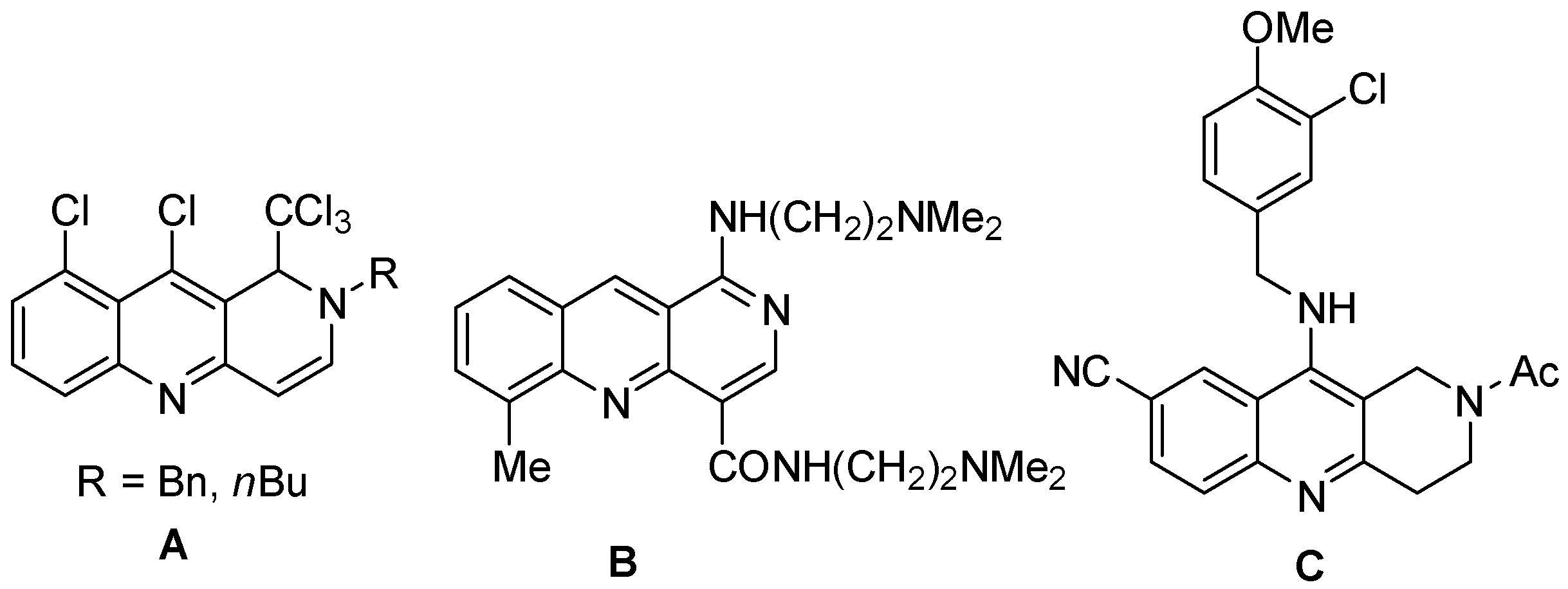
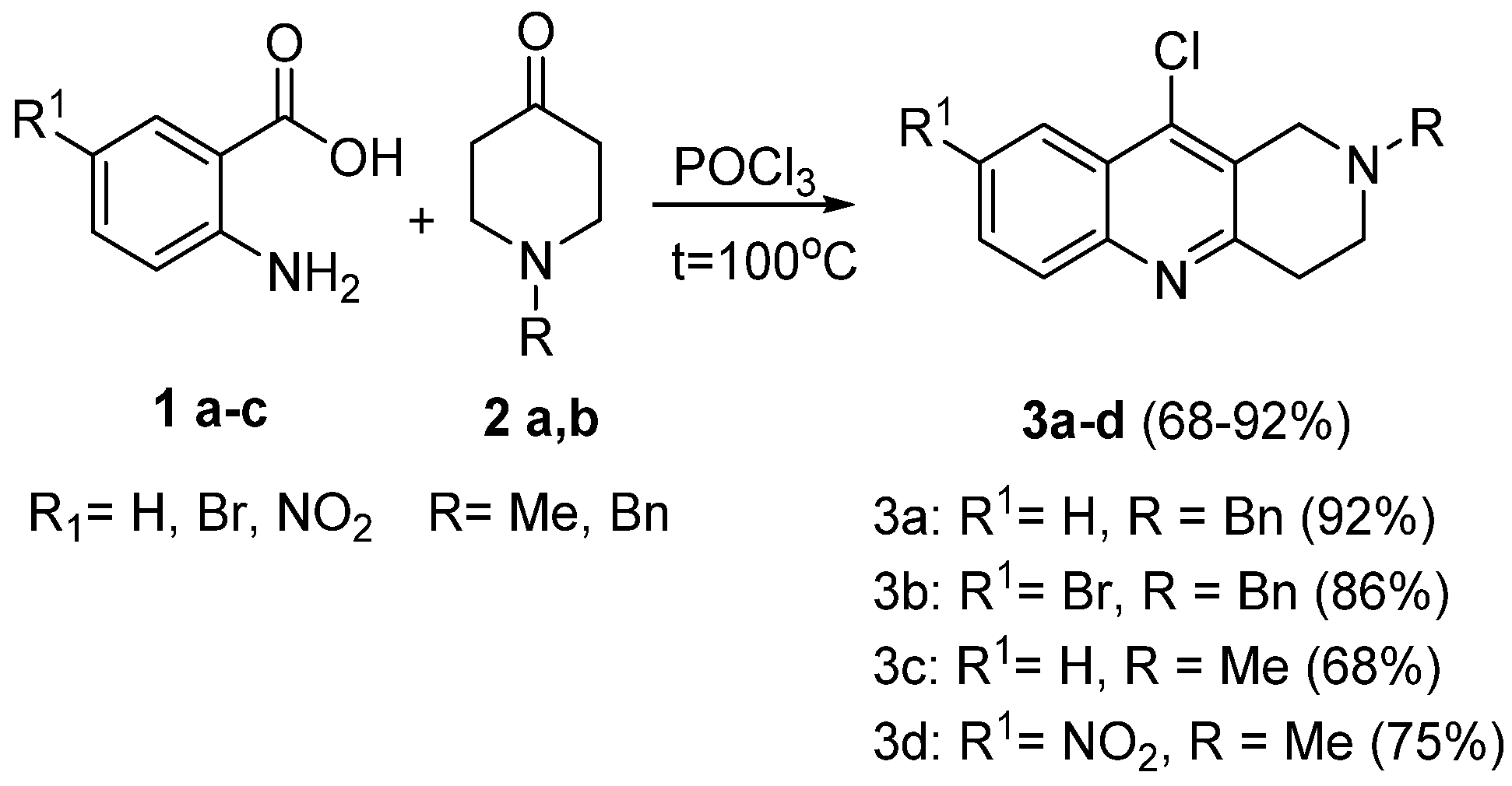

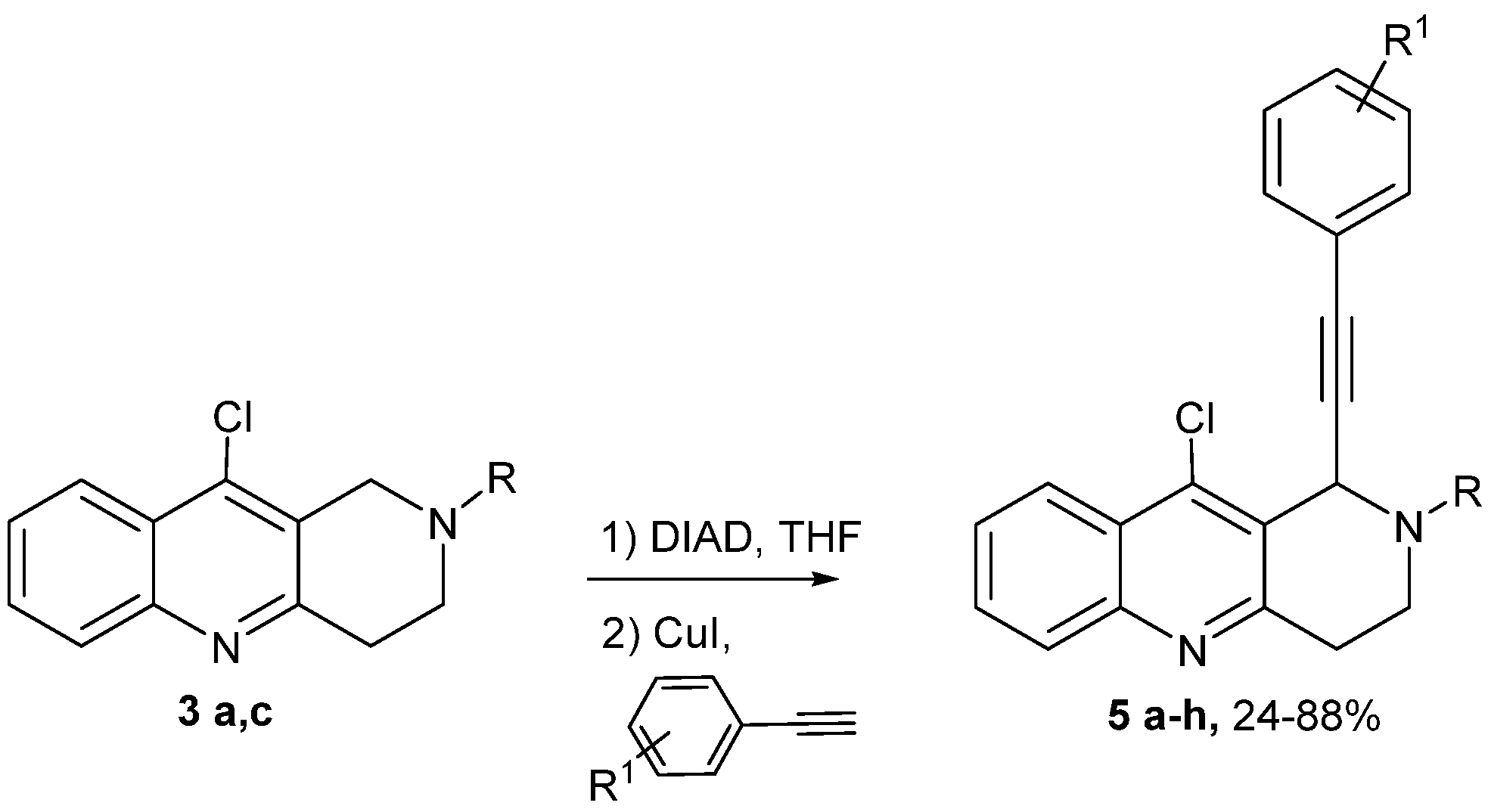
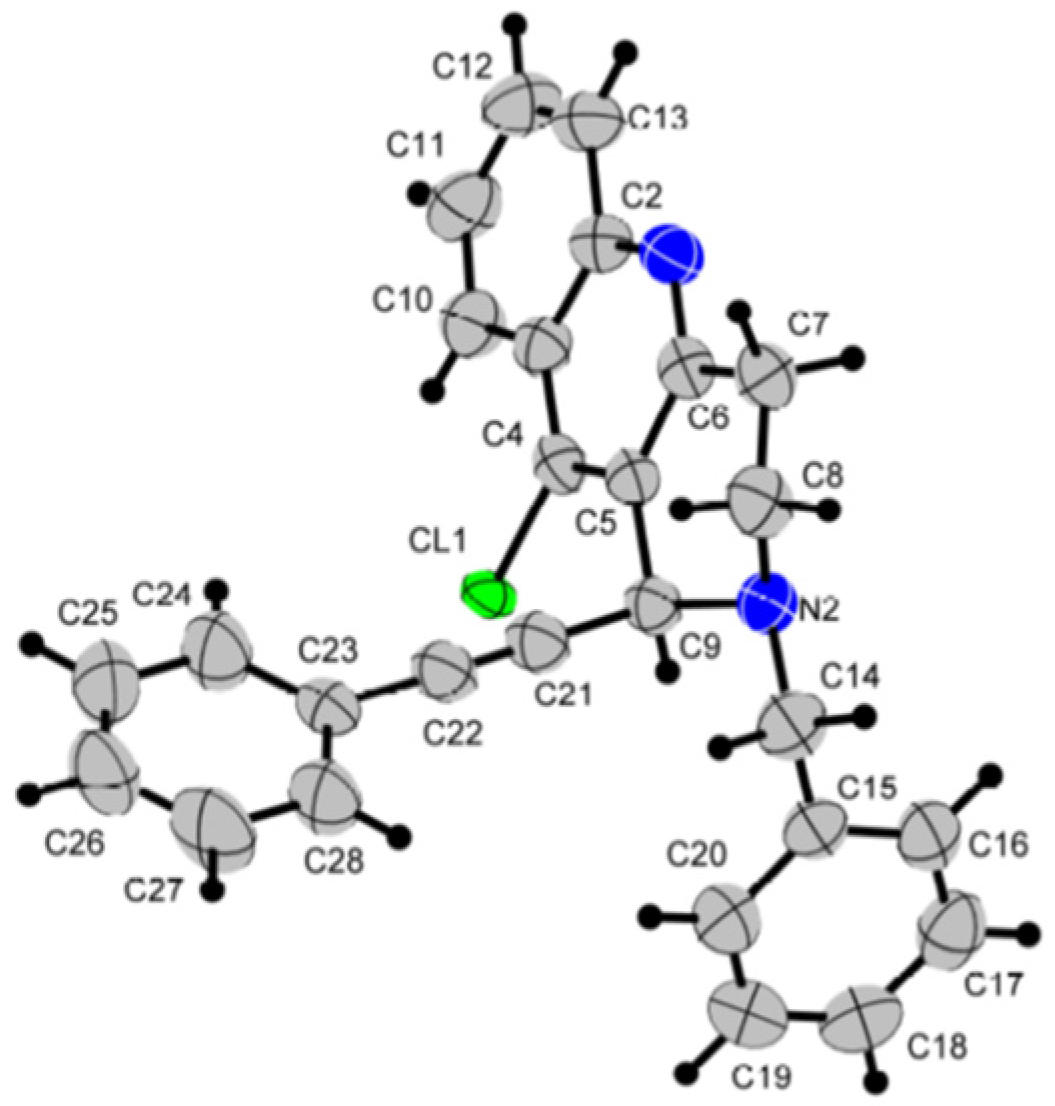



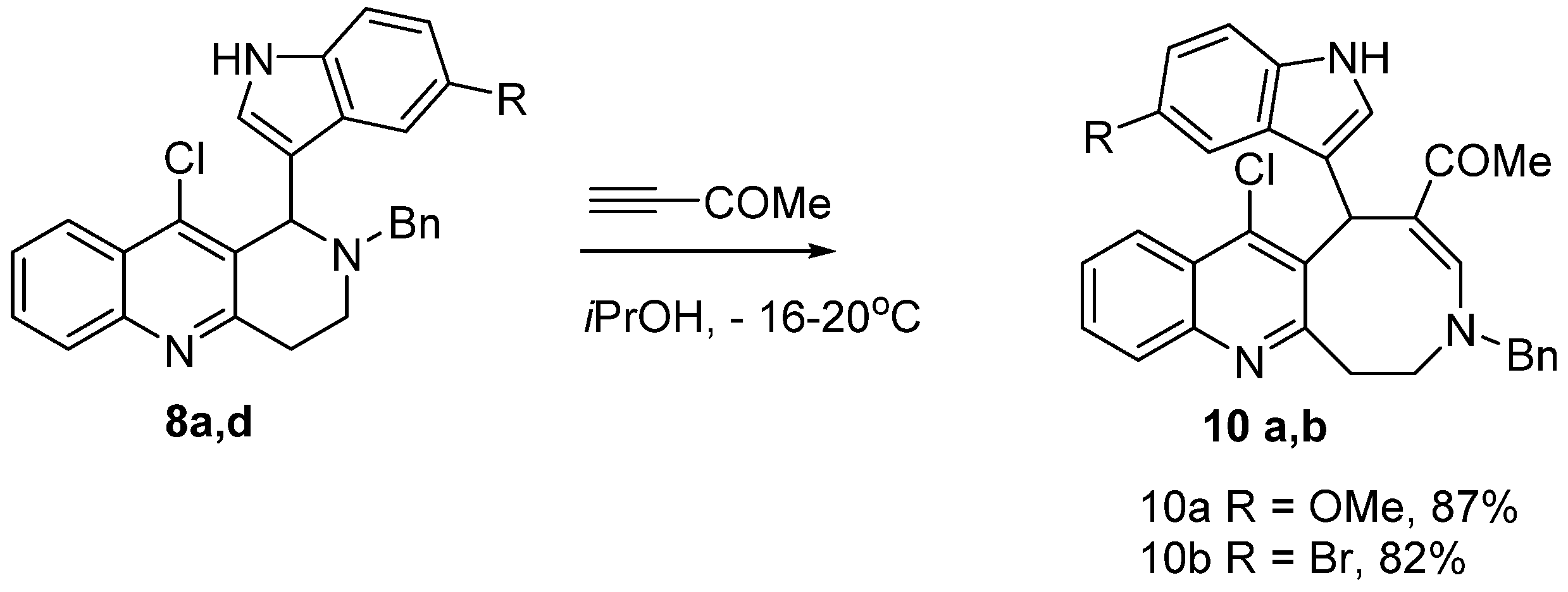
| Cmpd 5 | R | R1 | Yield, % |
|---|---|---|---|
| a | Bn | H | 24 |
| b | Bn | 3-OMe | 35 |
| c | Me | H | 32 |
| d | Me | 3-OMe | 85 |
| e | Me | 4-OMe | 88 |
| f | Me | 4-CF3 | 61 |
| g | Me | 4-F | 44 |
| h | Me | 4-Cl | 59 |
| Compound 6 | X | R1 | Yield, % |
|---|---|---|---|
| a | CO2Me | 4-F | 27 |
| b | CO2Me | 3-OMe | 22 |
| c | COMe | H | 37 |
| d | COMe | 3-OMe | 34 |
| e | COMe | 4-CF3 | 42 |
| Cmpds 5 | MAO A % Inhibition a | MAO B | |
|---|---|---|---|
| % Inhibition a | IC50 (μM) b | ||
| c | 24 ± 8 | 28 ± 1 | |
| d | 49 ± 2 | 7.09 ± 0.07 | |
| e | 24 ± 9 | 42 ± 6 | |
| f | 20 ± 1 | 14.3 ± 0.9 | |
| g | 39 ± 3 | 1.35 ± 0.07 | |
| h | 38 ± 4 | 8.65 ± 1.01 | |
| Pargyline | 10.9 ± 0.6 | 2.69 ± 0.48 | |
Disclaimer/Publisher’s Note: The statements, opinions and data contained in all publications are solely those of the individual author(s) and contributor(s) and not of MDPI and/or the editor(s). MDPI and/or the editor(s) disclaim responsibility for any injury to people or property resulting from any ideas, methods, instructions or products referred to in the content. |
© 2023 by the authors. Licensee MDPI, Basel, Switzerland. This article is an open access article distributed under the terms and conditions of the Creative Commons Attribution (CC BY) license (https://creativecommons.org/licenses/by/4.0/).
Share and Cite
Kulikova, L.N.; Raesi, G.R.; Levickaya, D.D.; Purgatorio, R.; Spada, G.L.; Catto, M.; Altomare, C.D.; Voskressensky, L.G. Synthesis of Novel Benzo[b][1,6]naphthyridine Derivatives and Investigation of Their Potential as Scaffolds of MAO Inhibitors. Molecules 2023, 28, 1662. https://doi.org/10.3390/molecules28041662
Kulikova LN, Raesi GR, Levickaya DD, Purgatorio R, Spada GL, Catto M, Altomare CD, Voskressensky LG. Synthesis of Novel Benzo[b][1,6]naphthyridine Derivatives and Investigation of Their Potential as Scaffolds of MAO Inhibitors. Molecules. 2023; 28(4):1662. https://doi.org/10.3390/molecules28041662
Chicago/Turabian StyleKulikova, Larisa N., Ghulam Reza Raesi, Daria D. Levickaya, Rosa Purgatorio, Gabriella La Spada, Marco Catto, Cosimo D. Altomare, and Leonid G. Voskressensky. 2023. "Synthesis of Novel Benzo[b][1,6]naphthyridine Derivatives and Investigation of Their Potential as Scaffolds of MAO Inhibitors" Molecules 28, no. 4: 1662. https://doi.org/10.3390/molecules28041662
APA StyleKulikova, L. N., Raesi, G. R., Levickaya, D. D., Purgatorio, R., Spada, G. L., Catto, M., Altomare, C. D., & Voskressensky, L. G. (2023). Synthesis of Novel Benzo[b][1,6]naphthyridine Derivatives and Investigation of Their Potential as Scaffolds of MAO Inhibitors. Molecules, 28(4), 1662. https://doi.org/10.3390/molecules28041662








